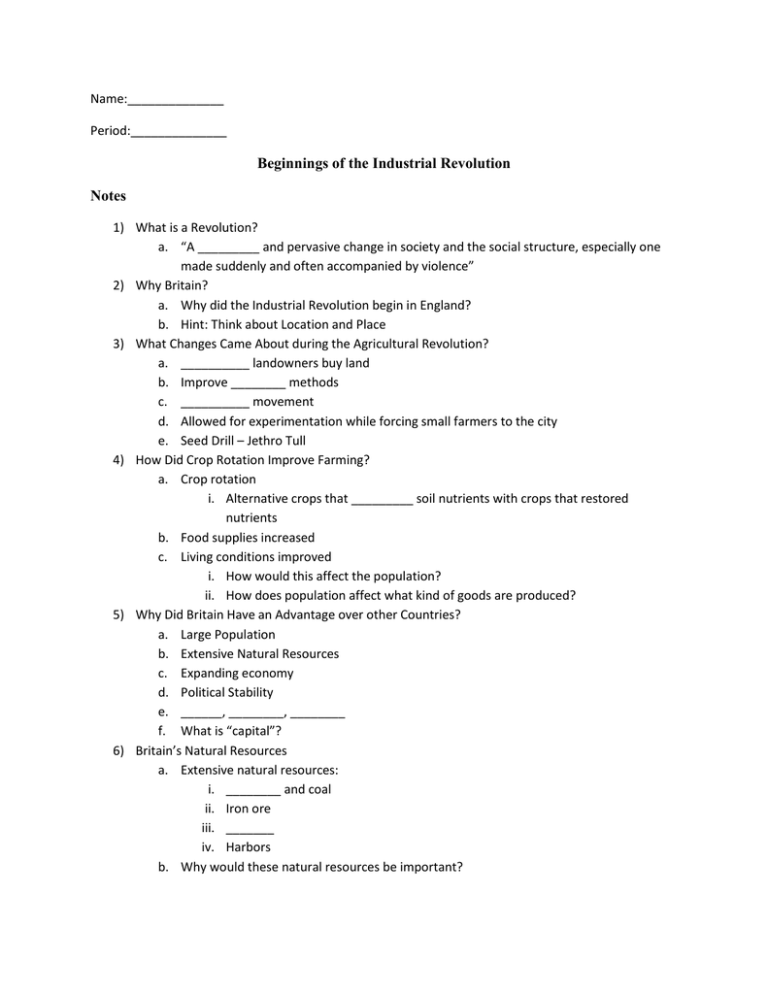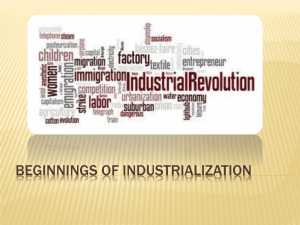Beginnings of Industrialization Notes
advertisement

Name:______________ Period:______________ Beginnings of the Industrial Revolution Notes 1) What is a Revolution? a. “A _________ and pervasive change in society and the social structure, especially one made suddenly and often accompanied by violence” 2) Why Britain? a. Why did the Industrial Revolution begin in England? b. Hint: Think about Location and Place 3) What Changes Came About during the Agricultural Revolution? a. __________ landowners buy land b. Improve ________ methods c. __________ movement d. Allowed for experimentation while forcing small farmers to the city e. Seed Drill – Jethro Tull 4) How Did Crop Rotation Improve Farming? a. Crop rotation i. Alternative crops that _________ soil nutrients with crops that restored nutrients b. Food supplies increased c. Living conditions improved i. How would this affect the population? ii. How does population affect what kind of goods are produced? 5) Why Did Britain Have an Advantage over other Countries? a. Large Population b. Extensive Natural Resources c. Expanding economy d. Political Stability e. ______, ________, ________ f. What is “capital”? 6) Britain’s Natural Resources a. Extensive natural resources: i. ________ and coal ii. Iron ore iii. _______ iv. Harbors b. Why would these natural resources be important? c. Industrialization – the process of developing machine production of goods – required such resources Part II: “The Children Who Built Victorian Britain” Video Worksheet 1.) What was the “raw material found in plentiful supply?” 2.) According to Robert Blincoe, what were the children taught when they arrived at the Cotton Mill? 3.) “Work was a substitute for social welfare.” What does this mean? 4.) How long would children often work? Did the children benefit at all from the work experience? 5.) Why were children more preferable workers than adults? Part II: Interact with History You are a 15-year-old living in England where the Industrial Revolution has spurred the growth of thousands of factories. Cheap labor is in great demand. Like millions of other teenagers, you do not go to school. Instead you work in a factory six days a week, 14 hours a day. The small pay you receive is needed to help support your family. You trudge to work before dawn every day and work until after sundown. The dangerous machines injure your fellow workers. Minding the machines is exhausting, dirty, and dangerous. Inside the factory the air is foul, and it is so dark it is hard to see. What would you do to change your situation? Examining the issues: 1.) What factory conditions concern you the most? 2.) Would you attempt to change conditions in the factory? Why or why not? 3.) Would you join a union, go to school, or run away? Part III: Practice Questions 1.) What were some of the effects of enclosure and crop rotation? 2.) How did the population growth spur the Industrial Revolution? 3.) List the four natural resources needed for industrialization and how each is used Britain’s Natural Resources Uses 4.) Show the causes and effects of the agricultural revolution and the Industrial Revolution Causes Effects Agricultural Revolution Industrial Revolution 5.) Even through years of social reform movement pushing for the freedoms of individuals, child labor still persists in the world today. Identify a specific country where child labor still exists. Answer the following questions: a. Describe the conditions of child labor in that country. i. How did it begin? ii. Who’s responsible? iii. In what ways are the children being forced to work? iv. Is anything being done to stop it? b. What is your reaction to the existence of child labor today? What can we do to help change it?


